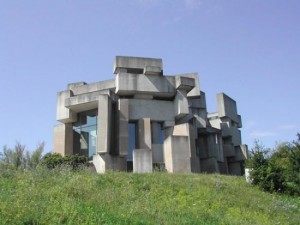The church of the Most Holy Trinity, Vienna, 1976.
Heidemarie Seblatnig, Editor
(Vienna, WUV, 2006)
In Hetzendorf, Heidemarie Seblatnig led a team of authors in analyzing the eruption of iconoclasm into the Catholic Church in the middle of the 20th century. Profane Sacred Architecture in Vienna since 1960 is a kind of “prequel” to this larger work. It has fewer essays, is less broad in scope and provides only English and German versions of each essay. The topic, moreover, is significantly different from Hetzendorf. While the later work dealt with the issues raised by “renovations” of existing churches, Profane Sacred Architecture deals with the construction of new churches. This is a topic that is moot in most places. For since the 1970’s, other than in Italy and the United States, few if any new churches have been built. Many more have been closed, including once-celebrated examples of modernity. It seems that the glory of modernism can be a very transient thing. Just in our part of the world, the monstrous modernistic Catholic chapel of New York University on Washington Square had been completed with great fanfare before the Council was even concluded. It was razed a couple of years ago without attracting the slightest attention from any quarter.
Essays by Fr. Uwe Michael Lang, Michael S. Rose, Michael Wimmer and Don Reto Nay provide a more universal conceptual framework to accompany the discussion of specific Viennese developments. As might be expected, the authors strongly argue for celebrating the mass “facing the Lord” and orienting the architecture of the church accordingly. Michael Rose seeks to identify the three “natural laws” or essential characteristics of a Catholic church. It must have verticality. It must have iconography: images but also symbols inherent in the architecture itself. And it must have permanence – the significance of this latter item will become apparent when considering some examples of modern church architecture. Michael Wimmer provides an intriguing speculative analysis of the stages of Christian architecture as reflecting the development of Christian spiritual life. He views modernity as starting with a coldly intellectual phase in the 18th century and culminating in the current age of spiritual uncertainty.
Moving to the more concrete, the illustrations of Viennese churches included in this work are a chronicle of the most inept architecture imaginable, all created under Cardinal Franz König, the darling of Catholic progressivism. (See above) Construction of course petered out in the 1970’s. Peter Ferschin describes how teams of students of architecture at the Technical University of Vienna analyzed these structures and drafted “virtual” reconstructions. These redesigns had as the goal a closer approximation of the architecture to the requirements of the Catholic mystery. I fear that most people reading this review may well be startled by the results. But at least these students understand that making a modern church Catholic is more than a matter of inserting into a modernistic space some third–rate devotional art – the preferred solution in the New York area. The structure itself needs to be addressed.
Finally, the editor confronts the thought and works of Ottokar Uhl, a local hero of Catholic modernity. In him, the modern movement reaches its logical conclusion: the church structure as such disappears entirely and is replaced by a temporary shed. These are Uhl’s “portable” or “demountable” churches. Uhl proclaims the end of any “sacred” architecture and interprets active “participation” of the faithful as superseding “private devotion.” In a highly revealing comment, Uhl asserts that the Catholic church building of modernity should forsake any kind of dominant position in the streetscape. Such appearances are an undesirable image of the church’s position in society for our time. The church building does not need to be symbolic because Christianity has rejected all such “myths.” “Secularization is a Christian process.” The Conciliar communities thus vanish from the “public square” and the structures that house them offer outsiders (and their own members) no distinctive identifying architectural characteristics. The triumph of the profane over the sacred is complete.
Profane Sacred Architecture in Vienna is a brave attempt to understand these developments and to outline initial Catholic responses. Given the rather steep price of this work and Hetzendorf, the latter will be the best place to start for the non-specialist reader seeking orientation in this area.

Related Articles
1 user responded in this post